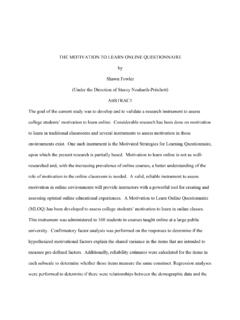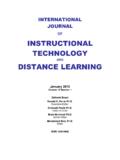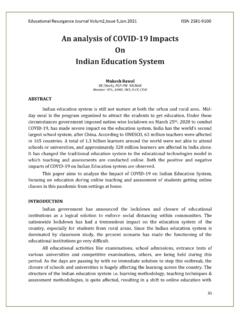Transcription of Success rates of online versus traditional college students
1 Research in higher education Journal Success rates of online , Page 1 Success rates of online versus traditional college students Dawn Wilson Fayetteville State University David Allen Fayetteville State University ABSTRACT Are students setting themselves up for failure by taking online courses? Should students be restricted from taking online courses if they have not reached a certain GPA? Should students who fail or withdraw from an online course be required to take to traditional courses for at least one semester? At one Historically Black college or University (HBCU) there seemed to be a marked difference in the Success of students taking online courses versus students taking face-to-face courses. online students seemed to have a higher withdrawal rate, failure rate and seemed to have more trouble completing assignments by the deadline, if at all.
2 Therefore, in the spring 2010 semester data were gathered from four management courses, two online and two face-to-face, across two different subjects, with different professors and different students to see if there was any notable difference in online achievement versus face-to-face achievement and if there was a difference in achievement why were online students performing so poorly as compared to face-to-face students . Keywords: online , learning, face-to-face, GPA, HBCU Research in higher education Journal Success rates of online , Page 2 INTRODUCTION Many studies have been conducted regarding online learning. Some authors report that online learning can be very effective depending on the subject, although perhaps, in courses where problem solving is required, such as science or math courses, face-to-face instruction or at least synchronous chat with the instructor may be preferred over asynchronous, online learning.
3 (Quillen, 2010). Many researchers found no significant difference in satisfaction, motivation or achievement between online and traditional learners (Bernard, R., Abrami, P., Lou, Y., Borokhovski, E., Wade, A., Wozney, L., Wallet, P., Fiset, M., & Huang, B., 2004). Other investigators found that online learning can be as effective as traditional learning (Zhao, Y., Lei, J., Yan, B., Lai, C., & Tan, , 2005). According to a 2009 study conducted by the Department of education , which reviewed more than 1,000 studies conducted on online learning between 1996 and 2008, students performed better in an online education situation than in face-to-face situations, on average.(Feintuch, 2010). Dr. Robert Murphy, senior research scientist for technology learning at SRI and one of the report's authors, states, as cited in Feintuch (2010) We concluded from the research that more time is spent on learning in the online environment.
4 Many of the systems provide real-time feedback to students and individualized instruction. It also appears that the online -learning environment is more engaging" (p. 20). However, that does not mean that online learning is as effective for all learners. Toch (2010) states The younger and more disadvantaged students are, the more they need school to be a place rather than merely a process, the more they need to be connected to a network of adults supporting them in many different ways every day ( ). While Toch is referring to k-12 students in his comments, could this statement also be true of college students ? Harrington (1999) notes in her study, that students taking a traditional statistics course did well overall, regardless of GPA.
5 students in the online course, who had high GPAs also did well; however, online students with previously low GPAs did not fare as well as either of the other groups. Artino (2008) notes that online learning requires autonomy and self-direction and that students must be able to perform independently. Harris and Parrish (2006) found that when they compared two courses, one online and one traditional , that there was a significant difference in the learning outcomes between two courses and that the in-class students received significantly higher grades and had a lower dropout rate. Purpose The purpose of this research is to determine whether there is a significant difference in the Success rates of online versus face-to-face learners at one HBCU and if there is a significant difference what are the characteristics of successful online learners versus online learners who either fail or withdraw from courses.
6 Research Questions 1. Is there a significant difference in the Success rates of online students versus face-to-face students in two different courses within the school of business? 2. Are there any common characteristics of the successful online students in the two business courses? 3. If there are common characteristics, what are they? Research in higher education Journal Success rates of online , Page 3 Model The model chosen for this study presupposes that precollege characteristics and choices made during college have significant impacts on academic performance, and that preference for course delivery mode makes a difference in outcome. The present study focuses on academic as well as demographic factors in addition to the decision to take a course online versus face-to-face.
7 Figure 1 displays a regression model focused on external factors presumed to impact grade performance. Each element was chosen as a result of historical data at the study institution that indicate a likely influence on course delivery preference. students were compared based on their gender, broad ethnic category (due to lack of heterogeneity, students were categorized as either Black or Non-Black), high school grades, SAT scores, whether they entered the institution as either a first-time student or a transfer student, age, cumulative college GPA, total earned hours, and whether they were lower- or upper-division students . The intermediary variable was course mode of delivery as either online or face-to-face. The dependent variable consisted of course grade.
8 METHODOLOGY This study looked at a over 100 students in four different courses, two online , two traditional to determine whether there was a significant difference in the achievement of these students and, if there was, what in their background made them more successful. The sample consisted of 101 undergraduate students who elected to take either Management 311 (Principles of Management) or Management 420 (Organizational Behavior). The former is the study of the theory and process of management principles and basic organization behavior. The latter is the study of human behavior at the individual, group and organizational level. Both courses were taught online and face-to-face. Table 1 describes the overall characteristics of these students as well as the intercorrelations and course delivery differences.
9 Data Analysis Ten measures were taken in this study as described previously. Analyses followed a three step approach. First, a comparison of descriptive information as shown in Table 1 using simple t-test comparisons between course delivery types was conducted. Second, analysis of variance (ANOVA) of a 2X2 table was performed as seen in Table 2 using two levels of behavior (course completers vs. withdrawers) and delivery mode ( online vs. face-to-face). And third, multiple regression analysis was conducted in Table 3 regressing nine variables on course grade as the dependent variable. As a follow-up strategy in the event that variables might be significantly related to course grade, a backward elimination method was applied to determine if a reduced set of variables would indicate statistical significance (ie, variables with the largest p-value exceeding the specified cutoff value are removed one at a time from the model).
10 Akaike s Information Criteria (AIC) was also applied to the data to simultaneously evaluate all possible subsets of the multiple regression model. Models associated with the smallest AICs are considered the best fit. Research in higher education Journal Success rates of online , Page 4 FINDINGS The primary purpose of this study was to determine whether there was a significant difference in the Success rates of online versus face-to-face learners at one HBCU and if there was a significant difference what were the characteristics of successful online learners versus online learners who either failed or withdrew from courses. Findings from Table 1 indicated that there were three main differences between online and face-to-face students .
















